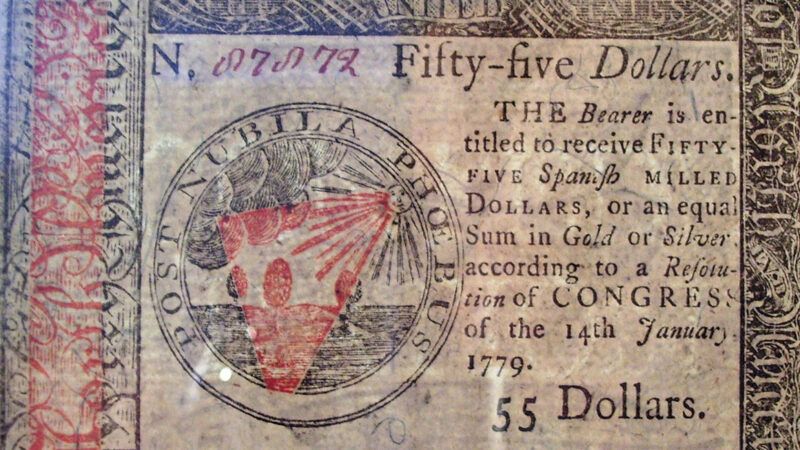There's Nothing Modern About MMT
Similar measures have been tried before, right here in America, and they have worked. But that's actually not good news for MMT fans today.

Modern Monetary Theory (MMT) tells us that governments should finance public spending by creating money. To prevent inflation, MMT advocates say, the government should use taxes to siphon off excess purchasing power, which supposedly would enable the public sector to greatly expand its activities, eliminating the scourge of underemployment.
At a time of skyrocketing national debt and mild inflation, what was once a fringe school of thought with few adherents has captured the public imagination. Rebutting MMT's claims requires a little history, which shows there is nothing "modern" about its prescriptions.
MMT promoters, who are mostly journalists and public intellectuals rather than professional economists, start with a couple of obvious truths: Governments can't default if their debts are denominated in their own currency, and they can create a demand for their currency by imposing tax obligations. From those premises, the theory's supporters leap to some extraordinary conclusions: They argue that there are too many idle resources even in healthy economies and that fiat-money finance is the key to mobilizing those resources. It sounds like clickbait: "Learn this one weird trick to jumpstart the economy!"
Similar measures have been tried before, right here in America, and they have worked. But that isn't good news for MMT fans, because understanding why currency finance worked then means seeing why it won't work now.
A popular myth about early American fiat money claims that various colonial and state governments created hyperinflationary disasters after they experimented with currency finance. But while New England and the Carolinas occasionally made a mess of things before the Revolutionary War, most colonies had a lot of success in issuing their own currency.
E. James Ferguson, a historian of American public finance, explains how it worked: "Governments met expenses by issuing a paper medium….They redeemed this paper, not by giving specie [i.e., hard money, such as gold and silver coins] to those who held it, but by accepting it for taxes or other payments."
This system had two great benefits. First, because hard money was scarce in the colonies, fiat money provided Americans with a much-needed medium of exchange. Second, controlled depreciation—a gradual fall in money's purchasing power, which redistributed wealth from the users of paper money to the issuers—functioned as a uniform and relatively unburdensome form of indirect taxation. This helped governments raise revenue at a time when assessing direct taxes was prohibitively expensive.
These practices lasted into the Early National Period, between the ratification of the Articles of Confederation and the Constitution. Runaway inflation was rare. The colonists-turned-citizens were quite happy with currency finance. In fact, liberty-loving Americans saw fiat money as a way of preserving their freedom. "Most people regarded specie payment as signifying permanent debts, heavy taxes—in a word, oppression," Ferguson observes. "Liberty in their minds was associated with paper money." It meant a debt that was never retired—merely rolled over. Permanent government debt in the case of Great Britain came to be identified with empire, mercantilism, and other "great game" forms of statecraft—all things Jeffersonians, at least, wanted to avoid.
Economic historian Edwin J. Perkins concurs. "Most governments retired or refinanced through debt obligations the fiat currencies emitted in the 1780s at face value, or thereabouts, through tax collections or the mortgage payments of private borrowers," Perkins writes.
Currency entered circulation in two ways. The first was through state-authorized "land banks," which provided short-term mortgages for farm or business improvement. The second was through tax anticipation bills, usually reserved for wartime or financial emergencies. That worked because, to paraphrase a popular economic maxim, it was "timely, targeted, and temporary."
If anything, this system worked too well, at least in the eyes of the Founding Fathers. Men like Alexander Hamilton, Robert Morris, and George Washington were angling for a stronger national government, and they viewed local traditions of public finance as a barrier to their centralizing schemes. Although the nationalists prevailed with the ratification of the Constitution, that doesn't change the impressive record of currency finance during the preconstitutional period.
But that record also explains why fiat-money finance, under the guise of MMT, won't work today. Early American currency finance was kept in check by several political feedback mechanisms.
First was local democratic control. Because of much smaller populations, legislatures were easier to discipline.
Second was jurisdictional competition. If a legislature let currency finance get out of hand in one place, a jurisdiction whose government had its books in order was never too far away.
Third was economic independence. Because of agriculture's prevalence, subsistence farming and barter with neighbors provided an outside option, especially in rural areas.
Fourth was that currency finance responded to specific needs. Relatively small and targeted governments could employ fiat money as a financing mechanism more safely.
None of these conditions exist anymore. MMT advocates think their system can work on a national scale, but they're wrong. It's much harder for citizens to discipline the fiscal authority today, whether by "voting with their feet" or "taking to the hills." And because MMT would transform the fiscal-monetary landscape of the entire country, it is anything but "timely, targeted, and temporary."
Furthermore, even assuming taxes can keep inflation low, does anybody trust today's feckless politicians to enact unpopular levies? Without the supporting economic mechanisms, MMT is exactly what its detractors claim: a sure way to turn a functioning economy into a financial basket case.
Currency finance may be as American as apple pie, but MMT isn't. The political and economic circumstances that once made it attractive are gone, and they aren't coming back. Our fiscal process is indeed broken, and persistent unemployment is certainly a social malady. But MMT offers a cure that's worse than the disease. Finance by fiat money should stay in the history books.


Show Comments (128)